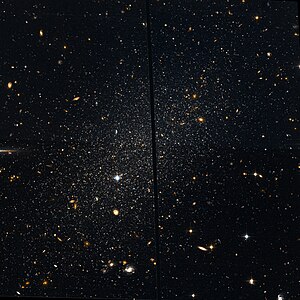Tucana dwarf galaxy
| Galaxy Tucana dwarf galaxy |
|
|---|---|

|
|
| Image of the HST's Tucana dwarf galaxy | |
| AladinLite | |
| Constellation | Toucan |
|
Position equinox : J2000.0 , epoch : J2000.0 |
|
| Right ascension | 22 h 41 m 49.0 s |
| declination | -64 ° 25 ′ 12 ″ |
| Appearance | |
| Morphological type | dE4 / dE5 |
| Brightness (visual) | 15.7 mag |
| Angular expansion | 2 ′, 9 × 1 ′, 2 |
| Physical data | |
| Affiliation | Local group |
| Radial velocity | (194 ± 4) km / s |
| distance | (2898000 ± 55,000) Lj / (889,000 ± 17,000) pc |
| Metallicity [Fe / H] | −1.8 |
| history | |
| discovery | RJ Lavery |
| Discovery date | 1990 |
| Catalog names | |
| PGC 69519 • SGC 2238.5-6441 | |
The Tucana Dwarf Galaxy is a spheroidal dwarf galaxy in the constellation of the Toucan and was discovered in 1990 by RJ Lavery of the Mount Stromlo Observatory .
It consists of very old stars and is relatively isolated from other galaxies in the Local Group . Its location on the opposite side of the Milky Way , seen from other galaxies in the Local Group, makes it an important research object in astronomy .
properties
classification
The Tucana dwarf galaxy is a spheroid dwarf galaxy of type dE5. It contains only one generation of old stars that were formed in a single phase , around the time the globular clusters of the Milky Way were formed. In contrast to other isolated dwarf galaxies, no star formation whatsoever can be detected in the Tucana dwarf galaxy .
composition
The galaxy contains very little neutral hydrogen gas . It has a significantly low metallicity of just −1.8. The metallicity also shows only relatively small scattered measured values, distributed over the entire dwarf galaxy. In addition, there are hardly any substructures to be found in the stellar distribution.
Coordinates
The Tucana Dwarf is located in a distance of about 889 k pc to our solar system and moves away from our sun at a speed of about 194 km / s . It is isolated from other galaxies in the Local Group and is located on their fringes. The location on the opposite side of the Milky Way, seen from other galaxies of the local group, makes it a valuable object, on the one hand to better understand the kinematics and history of the local group itself, on the other hand to understand the dependencies of the local conditions on the galaxy evolution explore.
The galaxy is one of the few spheroidal dwarfs of the Local Group that is not near either the Milky Way or the Andromeda Galaxy , which is why it was probably isolated throughout its evolution.
Individual evidence
- ↑ SIMBAD Astronomical Database . In: Results for Tucana Dwarf . Retrieved February 7, 2010.
- ↑ a b c d e NASA / IPAC EXTRAGALACTIC DATABASE
- ↑ a b c d e I. Saviane, Held, EV; Piotto, G .: CCD photometry of the Tucana dwarf galaxy. . In: Astronomy and Astrophysics . 315, November 1996, pp. 40-51. arxiv : astro-ph / 9601165 . bibcode : 1996A & A ... 315 ... 40S .
- ^ A b c Russell J. Lavery, Mighell, Kenneth J .: A new member of the Local Group - The Tucana dwarf galaxy . In: Astronomical Journal . 103, No. 1, January 1992, pp. 81-84. bibcode : 1992AJ .... 103 ... 81L . doi : 10.1086 / 116042 .
- ^ Sidney van den Bergh: The evolutionary history of low-luminosity local group dwarf galaxies . In: Astrophysical Journal . 428, June 1994, pp. 617-619. bibcode : 1994ApJ ... 428..617V . doi : 10.1086 / 174270 .
- ↑ T. Oosterloo, Da Costa, GS, Staveley-Smith, L .: HI Observations of the Tucana Dwarf Elliptical Galaxy . In: Astronomical Journal . 112, No. 5, November 1996, pp. 1969-1974. bibcode : 1996AJ .... 112.1969O . doi : 10.1086 / 118155 .
- ^ F. Fraternali, Tolstoy, E .; Irwin, MJ; Cole, AA: Life at the periphery of the Local Group: the kinematics of the Tucana dwarf galaxy . In: Astronomy and Astrophysics . May 2009. arxiv : 0903.4635 . bibcode : 2009A & A ... 499..121F . doi : 10.1051 / 0004-6361 / 200810830 .
- ^ Sidney van den Bergh : Updated Information on the Local Group . In: Publications of the Astronomical Society of the Pacific . 112, No. 770, April 2000, pp. 529-536. arxiv : astro-ph / 0001040 . bibcode : 2000PASP..112..529V . doi : 10.1086 / 316548 .
